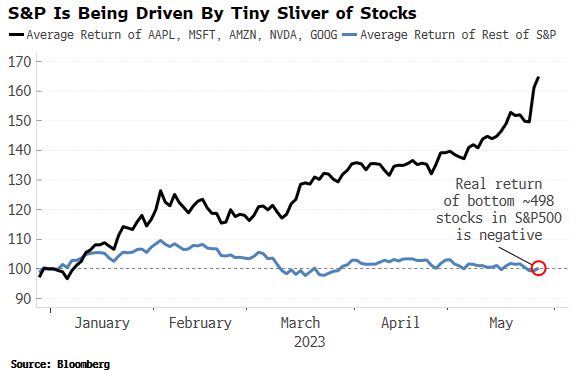Dear Old Friend,
“I suspect the jet lag has passed.” Shall I regret these words as I start a beautiful day. I’m writing from an old farmer’s attic in the center of a small agricultural canton.
The view from Europe is tame. There are people going on walks, eating fresh things… smiling… and not arguing over impractical matters during a generational financial crisis.
I look forward to June 8. Upon my return, a Florida friend will tell me about the latest thing dividing the nation… all thanks to the U.S. media’s campaign on its constituency’s sanity.
I’ll look forward to saying: “I’m glad I missed that last week.”
Now to the market, which continues its own battle on our sanity.
Defying Gravity (Has No One Written a NVDA/Wicked Parody Yet?)
Shares of NVIDIA (NVDA) popped above $400 on Tuesday as the runaway freight train of sentiment momentum carries artificial intelligence stocks and related names to nosebleed heights.
NVDA’s valuation is now so high that even Cathie Wood and the ARK Innovation Fund (ARKK) won’t own it. I don’t think I’ve ever seen her suggest that a valuation is too stretched for “innovation.” Shares have more than doubled since ARKK sold it.
I’ve been hard on ARKK in the past. So, in this case, I note that at least she owned the stock. I’ve largely spent my time looking at the valuations and avoiding it (even t rying to short it for 72 hours during a negative momentum event in February.)
rying to short it for 72 hours during a negative momentum event in February.)
Sure enough, NVDA has defied the rules of negative relative momentum this year, despite its valuation. My rule has largely been to get out of the way and stop trying to target NVDA as a short. The news cycle continues to propel its momentum higher.
I turned a 70% short win into a loss quickly by being stubborn.
The Insiders Are Buying
It’s odd to wake up to a large slog of emails (185 in my Gmail account). I guess I never realized how many emails I receive in the U.S. after market hours. That’s a cultural thing, right?
However, about 20 of them are from a feeder on FORM 4 insider buying activity. It appears that CFOs and CEOs are getting a little active this week. Let’s start with the broader S&P 500.

Don’t pay attention to the broader S&P 500. The 4,200 level has largely been driven by sentiment momentum and FOMO around the top 5 companies in the index. The same goes for the NASDAQ. The chart to the right shows pronounced weakness in the bottom of the index. The bottom ~498 stocks are down for the year. Something similar happened in 2021, but it not at this pace. So, it’s not surprising to go down the list of those 498 names and see insider buying. There’s a lot of buying in energy, real estate, and biotech. Let’s look.
The Top 10 Insider Buys Over the Last 10 Days
 It's not shocking to align recent performance with the latest insider purchases. The latest round of insider buying (delivered each premarket in Flashpoint Trader) includes another $250 million on Occidental (OXY) from Warren Buffett and Berkshire Hathaway (BRK.A). Executives at Energy Transfer (ET) have also been buying big in recent days. And Bill Ackman continues to load up on Howard Hughes (HHC). The chart to the right is the 10 largest insider buys in the last 10 days (Source: SECForm4.com)
It's not shocking to align recent performance with the latest insider purchases. The latest round of insider buying (delivered each premarket in Flashpoint Trader) includes another $250 million on Occidental (OXY) from Warren Buffett and Berkshire Hathaway (BRK.A). Executives at Energy Transfer (ET) have also been buying big in recent days. And Bill Ackman continues to load up on Howard Hughes (HHC). The chart to the right is the 10 largest insider buys in the last 10 days (Source: SECForm4.com)
Remember – Peter Lynch once said there are many reasons why executives might sell their stock. But insiders buy their stocks for one reason – and one reason only: They expect that it will move higher in the future (meaning it trades at a value today.)
Making Sense of The Debt Ceiling
I’ve been looking for some answers on the state of liquidity in the “system” and expectations for the markets after the Treasury Department makes refills the coffers of its General account.
My initial thesis projected that the Treasury Department’s refilling of its account would drain money out of the equity market and push the S&P 500 lower. Would this finally be the event that would push back against the AI-driven rally?
But I soon noticed that thesis became a mainstream concern – and one that seemed badly worded as it flowed across Twitter. When everyone becomes a self-appointed master of fiscal policy (or anything else) on social media, seek a counternarrative immediately. I’ve been trying to navigate this one all month.
As I noted, Tim Melvin and I had then started to conclude that the money to add $700 billion t0 $1.2 trillion in new bonds could come from the money markets – although it would require a steep increase in bond yields to make this possible.
I’d been looking for answers and am glad to have found some from a reliable source: Alf Peccatiello’s Macro Compass had a very strong breakdown defining “liquidity“ and what to expect. It’s on the paid side, but it’s very worth the time. I’ll likely reference it in the weeks ahead as Janet Yellen presses forward.
The key “nuance” is that money moving out of the money markets can absorb the blow without the sky falling. Narrative busted.
He also ran a regression analysis that suggests that liquidity analysis only provides a 3% to 5% level of expected returns in the market (during a 15-year stretch aligned with the post-GFC crisis era). It’s interesting, but I need to look deeper there.
I’ll let him and Stanley Druckenmiller duke it out over that conclusion – as the latter’s observations in the 1980s came before the U.S. central bank became our everyday obsession. Alf concludes with the view that liquidity will weaken, largely thanks to ensuing tightening efforts this year by central banks.
See you out there,
Garrett Baldwin
Florida Republic Capital (Available on Substack)
About the Author
Garrett Baldwin is a globally recognized research economist, financial writer, consultant, and political risk analyst with decades of trading experience and degrees in economics, cybersecurity, and business from Johns Hopkins, Purdue, Indiana University, and Northwestern.



